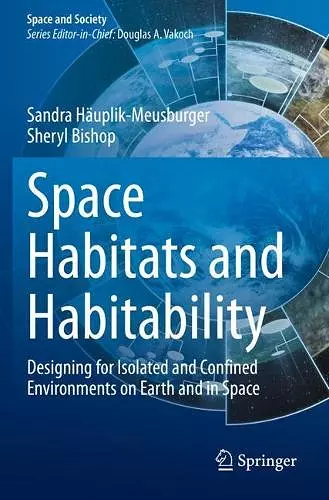Space Habitats and Habitability
Designing for Isolated and Confined Environments on Earth and in Space
Sandra Häuplik-Meusburger author Sheryl Bishop author
Format:Paperback
Publisher:Springer Nature Switzerland AG
Published:2nd Jun '22
Currently unavailable, and unfortunately no date known when it will be back
This paperback is available in another edition too:
- Hardback£129.99(9783030697396)

This book explores creative solutions to the unique challenges inherent in crafting livable spaces in extra-terrestrial environments. The goal is to foster a constructive dialogue between the researchers and planners of future (space) habitats. The authors explore the diverse concepts of the term Habitability from the perspectives of the inhabitants as well as the planners and social sciences.
The book provides an overview of the evolution and advancements of designed living spaces for manned space craft, as well as analogue research and simulation facilities in extreme environments on Earth. It highlights how various current and future concepts of Habitability have been translated into design and which ones are still missing. The main emphasis of this book is to identify the important factors that will provide for well-being in our future space environments and promote creative solutions to achieving living spaces where humans can thrive. Selected aspects are discussed from a socio-spatial professional background and possible applications are illustrated.
Human factors and habitability design are important topics for all working and living spaces. For space exploration, they are vital. While human factors and certain habitability issues have been integrated into the design process of manned spacecraft, there is a crucial need to move from mere survivability to factors that support thriving. As of today, the risk of an incompatible vehicle or habitat design has already been identified by NASA as recognized key risk to human health and performance in space. Habitability and human factors will become even more important determinants for the design of future long-term and commercial space facilities as larger and more diverse groups occupy off-earth habitats.
The book will not only benefit individuals and organizations responsible for manned space missions and mission simulators, but also provides relevant information to designers of terrestrial austere environments (e.g., remote operational and research facilities, hospitals, prisons, manufacturing). In addition it presents general insights on the socio-spatial relationship which is of interest to researchers of social sciences, engineers and architects.
“The book provides an excellent historical perspective on knowledge gained about human physiology, psychology, and confinement … . The authors do a thorough job of comparing extreme environments. … This book is well written and easy to read. Yet, despite the ease of reading, it’s also full of useful information that one can also consider it a resource. … it should sit on your bookshelf. All in all, a very valuable and well executed work by leaders in this field.” (Charles Cockell, The Observatory, Vol. 142 (1287), April, 2022)
ISBN: 9783030697426
Dimensions: unknown
Weight: 421g
250 pages